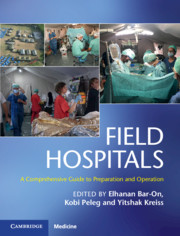Book contents
- Field Hospitals
- Field Hospitals
- Copyright page
- Contents
- Contributors
- Preface
- Section 1 History
- Section 2 Scenarios
- Section 3 Operational Considerations
- Section 4 Clinical Considerations
- Chapter 13 Advanced Triage Management for Emergency Medical Teams
- Chapter 14 Medical Aspects in a Field Hospital
- Chapter 15 Pediatrics in a Field Hospital
- Chapter 16 Surgery in a Field Hospital
- Chapter 17 Wound Management in a Field Hospital Environment
- Chapter 18 Orthopedics in a Field Hospital
- Chapter 19 Burn Care in a Field Hospital Environment
- Chapter 20 Obstetrics and Gynecology in a Field Hospital
- Chapter 21 Otolaryngology and Maxillofacial Surgery in a Field Hospital
- Chapter 22 Ophthalmology in a Field Hospital
- Chapter 23 Anesthesia and Pain Management in Field Hospitals
- Chapter 24 Intensive Care Unit Buildup Within a Field Hospital Setting
- Chapter 25 Infectious Diseases and Public Health in a Field Hospital
- Chapter 26 Primary and Ambulatory Care in a Field Hospital in Disaster Areas
- Chapter 27 Mental Health in a Field Hospital
- Chapter 28 Nursing in a Field Hospital
- Section 5 Additional Contextual Considerations
- Index
- Plate Section (PDF Only)
- References
Chapter 16 - Surgery in a Field Hospital
from Section 4 - Clinical Considerations
Published online by Cambridge University Press: 09 January 2020
- Field Hospitals
- Field Hospitals
- Copyright page
- Contents
- Contributors
- Preface
- Section 1 History
- Section 2 Scenarios
- Section 3 Operational Considerations
- Section 4 Clinical Considerations
- Chapter 13 Advanced Triage Management for Emergency Medical Teams
- Chapter 14 Medical Aspects in a Field Hospital
- Chapter 15 Pediatrics in a Field Hospital
- Chapter 16 Surgery in a Field Hospital
- Chapter 17 Wound Management in a Field Hospital Environment
- Chapter 18 Orthopedics in a Field Hospital
- Chapter 19 Burn Care in a Field Hospital Environment
- Chapter 20 Obstetrics and Gynecology in a Field Hospital
- Chapter 21 Otolaryngology and Maxillofacial Surgery in a Field Hospital
- Chapter 22 Ophthalmology in a Field Hospital
- Chapter 23 Anesthesia and Pain Management in Field Hospitals
- Chapter 24 Intensive Care Unit Buildup Within a Field Hospital Setting
- Chapter 25 Infectious Diseases and Public Health in a Field Hospital
- Chapter 26 Primary and Ambulatory Care in a Field Hospital in Disaster Areas
- Chapter 27 Mental Health in a Field Hospital
- Chapter 28 Nursing in a Field Hospital
- Section 5 Additional Contextual Considerations
- Index
- Plate Section (PDF Only)
- References
Summary
Surgical care for the weapon wounded and sick in conflict and disaster zones is clearly defined with internationally accepted guidelines for clinical care, the provision of resources, and infrastructure. This chapter outlines priorities in the organization and delivery of surgical care, with real-life examples of surgical activity in the field and ICRC experience of field hospital surgery. ICRC hospital programmes and surgical standards are summarized.
- Type
- Chapter
- Information
- Field HospitalsA Comprehensive Guide to Preparation and Operation, pp. 148 - 159Publisher: Cambridge University PressPrint publication year: 2020



